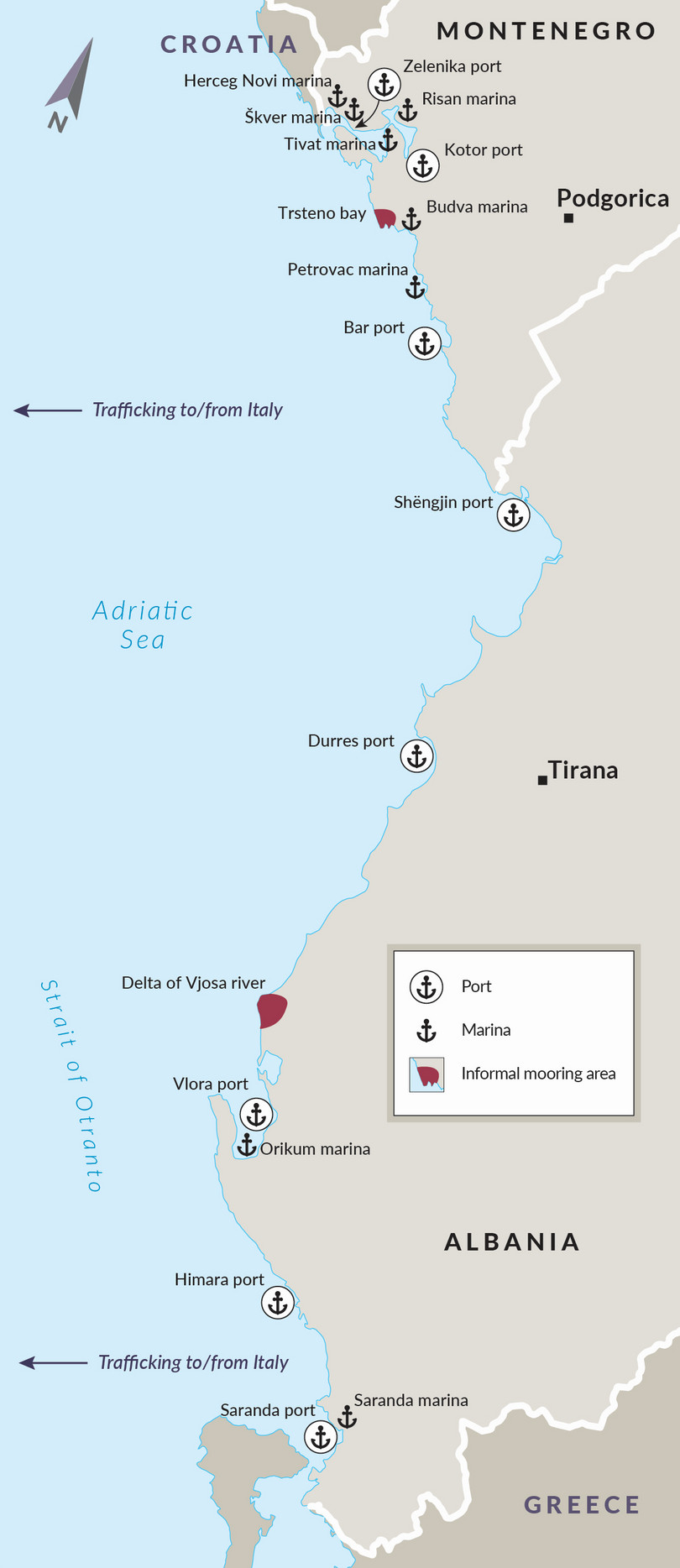Troubled waters: smuggling migrants across the Adriatic

Figure 3 Ports and marinas at risk for being used for migrant smuggling.
On 9 January 2021, 55 migrants from Syria, Iran and Egypt – including women and children – were rescued in rough seas off the coast of Albania. The speedboat that they had been travelling in, which had departed from Vlora, Albania, on its way to Italy, had broken down. The pilots had fled, and the boat was drifting and spilling fuel.1
This rescue operation followed two incidents in October and December 2020 where Montenegrin authorities intercepted two sailboats attempting to smuggle Kurds from Turkey via the Western Balkans to Italy. These occurrences suggest that more effective law enforcement and COVID-19-related restrictions along the traditional Balkan route have led smugglers to select alternative paths, including the Adriatic maritime routes. The closure of the Balkan route in March 2016 led to a significant decrease in the number of asylum-seekers and migrants moving through the Western Balkans. But since 2019, the number of refugees and migrants has again steadily increased.
Because of improved border controls between Greece and North Macedonia, a growing number of people on the move are travelling through Albania. Once they cross into the country, they either head north towards Montenegro or north-east through Kosovo into Serbia. Additionally, in the past few months there have been signs of increasing attempts to smuggle people across the Adriatic Sea to Italy.
The 55 migrants that were rescued on 9 January say that they paid between US$2 000 and US$4 000 each to smugglers for safe transport by yacht to Italy. Instead, they were transported in a speedboat.2 In early January, police in Vlora stopped another 21 migrants who were planning to illegally cross the Adriatic.3
The smuggling routes are well-established, dating back to the early 1990s when tens of thousands of Albanians tried to emigrate to Italy. As recently as 2004 – exactly 17 years to the day before the rescue of the 55 migrants – 28 Albanians drowned at sea while trying to cross from Vlora across the Strait of Otranto to Italy.4 Now it is mostly foreigners from the Middle East and North Africa who are being smuggled to Italy from Albanian shores.
In the past, the same routes were used to smuggle drugs, particularly cannabis, using speedboats. The problem was so acute that boats were seized and burned by the Albanian government. A ban on motorboats in Albanian territorial waters was introduced in 2006;5 it was finally lifted in 2013, to the relief of the tourism industry.6 The smuggling route from the shoreline around Fier and Vlora across the Strait of Otranto to Italy became popular again in 2016 when there was bumper crop of cannabis in Albania, but then tailed off. It will be interesting to see how the Albanian government reacts if the problem again worsens.
Neighbouring Montenegro is facing a similar challenge. In October 2020, Montenegrin police in the marina of Zelenika intercepted a sailboat named Poseidon with a Croatian flag and Serbian crew; it had originated in Budva and was heading for Italy.7 On inspecting the vessel, police discovered 52 Kurdish migrants on board.8 Smugglers in Turkey who had arranged the trip charged between €5 000 and €8 000 per person for the transfer to Italy, according to police sources.9 That means the smugglers earned approximately €300 000 from only one group of about fifty migrants, while the costs were estimated at around €100 000,10 leaving a considerable profit margin.
On 17 December 2020, Montenegrin police and maritime safety authorities, using a thermal-imaging sensor, detected an unknown boat around Trsteno bay, close to Budva. In cooperation with the Italian authorities, an observation helicopter from the Guardia di Finanza was deployed. The boat, named Marina, was flying a Swedish flag; it was intercepted and escorted to the port of Bar.11 Onboard, police found 39 migrants (including women and children) and arrested two smugglers from Turkey.12
These incidents tell us a number of things. First, the smuggling of migrants via the Western Balkans has not gone away; rather, it has moved further west. Albania, which for three decades has been a source country for migration, is now also a transit country. Second, in addition to trying to reach the European Union via Albania and Montenegro over a land route, some migrants are trying to enter Italy by boat. The stories covered in this article show that there are smugglers willing to facilitate such journeys at a sizeable profit. Third, these incidents highlight the vulnerability of marinas and informal mooring areas on the Adriatic coast as havens for smuggling. This is a risk that deserves more attention, not least by law enforcement officials.
Notes
-
Gomonia me 55 emigrantë në bord nga Vlora drejt Italisë/ Arrestohet 63 vjeçari nga Tirana. Roli që kishte ai, Panorama, 10 January 2021, www.panorama.com.al/trafiku-i-emigranteve-drejt-italise-me-gomone-arrestohet-63-vjecari-nga-tirana-roli-qe-kishte-ai. ↩
-
Rikthehet trafiku me gomone drejt Italisë, shpëtohen 55 emigrantë në det, Zëri i Amerikës (VOA), 9 January 2021, www.zeriamerikes.com/a/5731085.html. ↩
-
Jerola Ziaj, Trafik klandestinësh me gomone, policia ndalon 21 emigrantë dhe arreston pronarin e një shtëpie stehimi, Reporter, 4 June 2020, www.reporter.al/trafik-klandestinesh-me-gomone-policia-ndalon-21-emigrante-dhe-arreston-pronarin-e-nje-shtepie-stehimi. ↩
-
Isa Myzyraj, Përsëri emigrantë/ 9 Janari i 2004 dhe 9 Janari i 2021, Historia ime, 9 January 2021, www.historiaime.al/ndodhi-sot/perseri-emigrante-9-janari-i-2014-dhe-9-janari-i-2021. ↩
-
Moratoriumi i skafeve, rrezik per turizmin, Top Channel, 22 June 2009, top-channel.tv/2009/06/22/moratoriumi-i-skafeve-rrezik-per-turizmin. ↩
-
Moratoriumi i skafeve, pas 7 vjetësh rikthehet liria e lundrimit, Durrës Lajm, 2 March 2013, durreslajm.al/moratoriumi-i-skafeve-pas-7-vjet%C3%ABsh-rikthehet-liria-e-lundrimit. ↩
-
Interview with a journalist from Montenegro, December 2020. ↩
-
Emma Wallis, 52 migrants intercepted by Montenegrin authorities on route to Italy, Info Migrants, 19 October 2020, www.infomigrants.net/en/post/27994/52-migrants-intercepted-by-montenegrin-authorities-en-route-to-italy. ↩
-
Interview with a police officer from Montenegro, December 2020. ↩
-
Ibid. ↩
-
Jelena Jovanović and Blažo Hajduković, Otkriven brod sa 50 ilegalnih migranata, Vijesti, 17 December 2020, www.vijesti.me/vijesti/crna-hronika/495615/up-otkriven-brod-sa-50-ilegalnih-migranata. ↩
-
Interview with a journalist from Montenegro, January 2021. ↩
